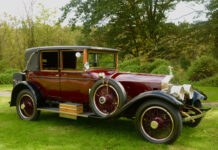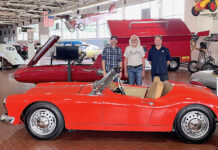By Jay Hirsch
After WWII the American car industry began to make cars bigger and more “glitzy.” The Willys Overland Car Company of Toledo would have no part in this and instead made no-nonesense vehicles when the company entered the civilian auto market in 1946 with their venerable Jeep, that icon of the four-wheel drive market still made today. In addition to the Jeep, Willys had the Jeepster which was a roadster-type vehicle; a pickup truck with two and four-wheel drive; and a two-door utility wagon with an all-steel body. In 1947 the only wagons being made in the U.S. auto industry had wood-and-steel bodies.
Crosley had an all-steel body wagon, but it was a sub-compact vehicle that could not go off road, whereas the Jeep wagon could. The Jeep Utility was the first SUV long before “sports utility vehicle” became a catchword. By 1957 Willlys and the American car-buying pubic knew the fun and sport capability of the Jeep Wagon. The Jeep Utility Wagon was made to buck the elements and rough terrain. In print ads of the time a Jeep Wagon was depicted with a canoe on its roof going up a rocky hill. With its high ground clearance of eight inches combined with 6.00 x 16 tires, rocks and other obstacle were of no hindrance to the Wagon or its occupants. The Wagon was also maneuverable off road with its 104-inch wheelbase and length of 176 inches
The Jeep Wagon was designed by industrial designer Brooks Stevens. With its high roof (the Wagon was 70 inches in height) it was both roomy and comfortable inside.
The wagon is well thought out with removable seats, a folding front-passenger seat, a floor fitted with oak runners, and ample windows for excellent visibility. The wagon was marketed as much as a commuting vehicle as a vehicle for country drives and camping.
The Jeep Wagon was the first Willys vehicle with independent front suspension. It was designed by Barney Roos who was chief engineer at Willys and was based on a transverse seven-leaf spring.
In 1953 Kaiser Motors bought Willys-Overland and changed the name to Willys Motor Company. Under Kaiser’s ownership the Super Hurricane 226 cid flathead, inline-six was offered as an option to the Willys 134 cid, inline four-cylinder engine. The inline four cylinder put out 72 horsepower while the Hurricane Six produced 105 horsepower. The only transmission available was a manual, floor-mounted three speed.
The Jeep wagon seen here was bought by its current owner, John Bernz, in 2005. John bought the Wagon for the same reason people bought it for in 1957 — a fun type of utility vehicle that can go anywhere off the beaten path. With its four-wheel-drive, the King of all four-wheel-drive vehicles, the Wagon could literally go anywhere in all kinds of weather.
Besides using the wagon to haul firewood from downed trees near his house, the family also has much fun when going for an ice cream run to Dairy Queen. His two boys would always ask John or his wife if they “could pick us up in school with the Wagon?” Their classmates thought the Wagon was “so cool!”
When John bought the Wagon, which was in Vermont, the motor was fine, but the transmission was “just a little sloppy,” as the owner had told him. John and his wife always had a soft spot in their heart for the Jeep Wagon, going back to their college days in 1990s Boston. On one of their summer weekend trips to Vermont in 2005 they saw the Wagon sitting in the driveway of a pre-1900s house. The house is what got their attention as they like old house’s with big porches. When they stopped in front of the house they then saw the Wagon at the far end of the driveway in front a small barn. As they got out of their car and began walking up the driveway, the owner, Henry, came out of the barn. John asked Henry about the Jeep and was told it had only two owners. The previous and original owner being Henry’s uncle.
The paint was faded “as you can see, and the tranny seems to slip a little in third gear,” Henry said.
The Wagon had 69,000 miles, as it was used to go to a town that was six miles away and “to the lake on weekends, which is ten miles.” Since the area gets a fair amount of snow, and many people had Jeeps beginning in the 1950s, all the roads were plowed, but no salt was used. Sand was spread from the rear of the trucks that plowed. That is why vehicles had and have very little rust.”
John and his wife took the Wagon for a ride and bought it that weekend. They came back the following weekend, and John drove it the 140 miles back to their house. Given the size of the motor, the rear axle ratio, and the limited use of the Wagon seen the past few years, John kept a cruising speed of 40 mph on the trip back home, with his wife following. The two boys rode in the Wagon, looking out the big glass windows at the scenery, just as kids did in 1957.
The Jeep could not have done much more than 40 mph anyway. A cruising speed of 50 to 55 mph was tops. In 1957 many roads had speed limits of 50 mph. The interstate highway system was in its infancy and V-8 engines were still in limited use on many cars.
That summer of 2005, John bought 235/80 x 16 radial tires to replace the 6.00 x 16 bias ply tires. The new tires were within an inch of the originals, keeping the look of the Jeep when new.
John did not want a lower look and did not want to lower the Wagon as he intended to go off road with it.
John was gong to have the three-speed-manual transmission rebuilt. The local shop where John brought the Wagon suggested using a later three-speed with over-drive, so John could cruise at 60 to 65 mph instead of 55 mph. John took the “suggestion” and is glad he did so. After getting the transmission done, John took the Wagon to a shop that worked on hot rods and inquired about having a dual master cylinder installed as the original master cylinder was “leaking a little.” The cost of a new dual master cylinder would actually cost less than an original single master. John said “do it and install new brake lines, brake hoses, rebuild the brake cylinders and wheel cylinders.”
The next stop after the brake job was at a local auto upholsterer to have new padding installed in the seats. The shop owner told John it would not cost much more to replace the vinyl seat covers, as both front seats were worn in areas, and since it was a smooth black vinyl, it was an easy match and the only stitching required was on the piping, which had to be replaced anyway.
That winter John and his family enjoyed the Wagon “immensely.” The following spring his sons said, “The paint really needs some help — let’s paint it.” John remembered Henry telling him that when he received the Wagon from his uncle, his uncle told him the paint was never “super shiny. It was a utility vehicle not a wedding car.” John decided to paint it with the of help his two sons, as both a learning experience and family time together.
John went to a car paint supply store in town and explained to the owner what he wanted to do. The owner told John to bring the Jeep by the next day. After seeing the Wagon the shop owner told John that all he should do is block sand the body smooth, and that he did not have to strip the paint. Then spray a coat of primer over that, sand the primer smooth and then spray the body. The color green John used is the same color green that was on the Wagon when new. The paint supply owner told John to let the paint cure a few weeks and to keep it in a garage when it rains. Otherwise leave the car in the sun when possible to help cure the paint. After three or four weeks, he was told to come back for rubbing compound to use with the car buffing machine to bring the paint up.
The result of the summer of 2006 paint job can be seen here.
John and his sons have taken the Jeep Wagon to local car shows where the Wagon always receives many accolades for how John and his sons have managed to retain much of the vehicle’s “originality.”
The Jeep Utility Wagon was made from 1947 to 1965 when the four-door Wagoneer introduced in 1963 became the flagship four-wheel-drive wagon. •



